lemlist Alternatives
Find 10 Lemlist alternatives in this guide. A direct comparison of features, pricing, and use cases to help you select the right tool for your team.

You might be using lemlist for its sales engagement tools or its B2B database. The platform performs well for automating outreach and personalizing messages at scale. It helps teams find decision-makers and improve response rates, making it a justified choice for many users.
However, no tool is perfect. Some users find it expensive, while others say the interface can be unintuitive. We've identified the best alternatives and analyzed their advantages and drawbacks compared to lemlist, based on G2 reviews, to help you shortlist your options. Let's get started.
Try 11x Digital Workers for Sales
For teams interested in adding digital workers to their sales process, 11x provides this option. They can take on tasks like lead research and initial outreach, letting your sales team concentrate on qualified leads.
You can explore how these digital workers operate and determine if they align with your company's sales objectives.
11x is a GTM platform where AI agents manage your sales process. Our agent, Alice, finds prospects, handles outreach on email and LinkedIn, and maintains your CRM. Julian, another agent, qualifies inbound leads and books meetings. We replace separate tools for data enrichment, outreach, and email warmup by unifying them.
lemlist Alternatives
Below, we review the main alternatives to lemlist. Each review covers pricing, features, and a direct comparison of their pros and cons against lemlist to help you find the right fit.
1) Mailshake
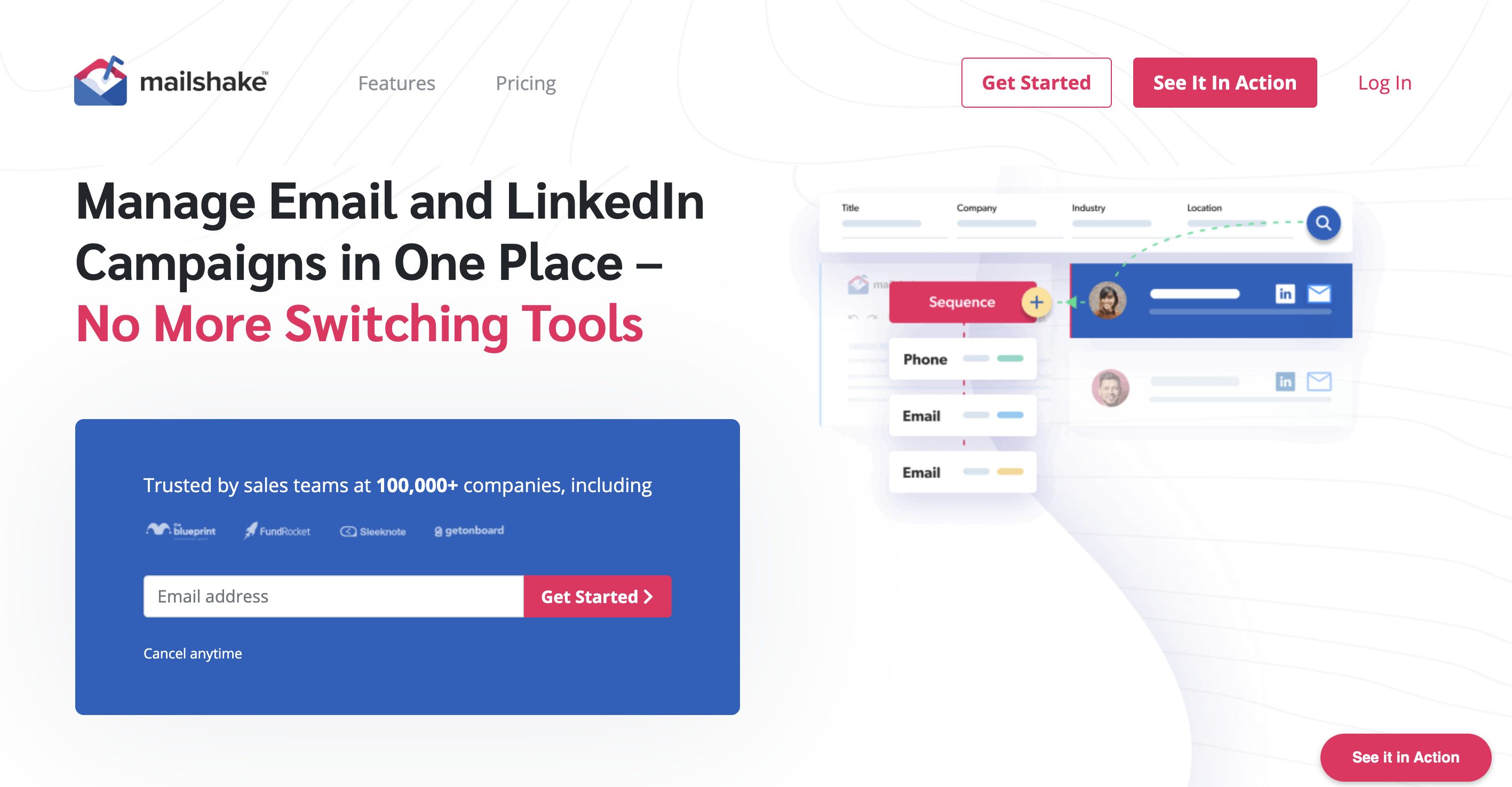
Mailshake is a sales-engagement platform for multi-channel outreach across email, phone, and LinkedIn. The tool helps teams connect with prospects and book meetings through automated follow-ups and AI-assisted content creation. It has a built-in database to search and purchase verified prospect email addresses.
The platform's design supports rapid onboarding for new sales representatives, with templates and training resources available for use.
Mailshake's Main Features
- Searches and purchases verified prospect email addresses by role, location, or company using a built-in database.
- Auto-generates and spins copy, subject lines, and A/B variants with its generative AI, SHAKEspeare.
- Includes a domain setup assistant, free email warm-up, list cleaning, and a copy analyzer to avoid spam folders.
- Places cold calls directly from the platform and includes them as steps in campaign sequences.
How Mailshake Compares to lemlist
Average Review Score: 4.7/5 stars based on 326 G2 reviews.
- Mailshake allows you to purchase verified prospect emails directly within the platform, which is a more integrated approach compared to lemlist's contact database.
- It includes a built-in phone dialer to make calls a direct step in your outreach sequences, a feature not present in lemlist.
- The platform's AI, SHAKEspeare, generates and spins entire copy variations for testing, offering a different method for A/B testing than lemlist's personalization AI.
- Its interface is designed for quick onboarding, which can be simpler for new users compared to lemlist's interface, which some find less intuitive.
Mailshake's Limitations Compared to lemlist
- Mailshake does not have the advanced image and video personalization features that lemlist offers, which can be a drawback for campaigns that depend on custom visuals.
- Some users report that its customization options are limited. Compared to lemlist's more flexible API, this may offer less room for building unique sales workflows.
- The tool lacks a large, active user community like the one lemlist fosters. This results in fewer opportunities for users to share successful strategies and get peer support.
Cost and Value Comparison
Mailshake's pricing starts at $29 per month, while lemlist provides a free plan and an Email Pro option at $55 per year, offering a lower entry cost. For multichannel capabilities, lemlist's Expert plan is $79 per month, which is more than Mailshake's $59 per month Email Outreach plan but less than its $99 per month Sales Engagement plan.
2) Reply.io
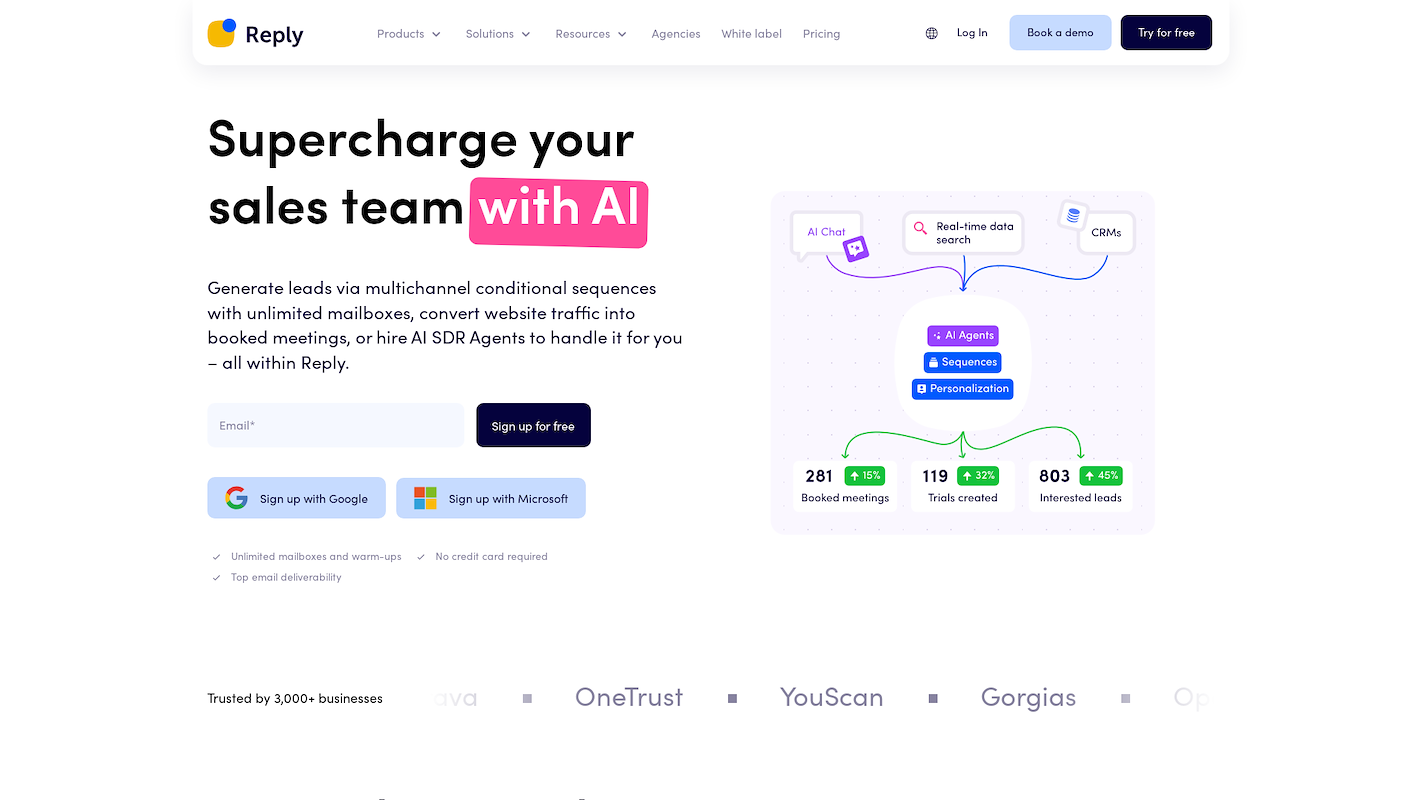
Reply.io is an AI sales engagement platform for B2B teams. It helps find prospects and engage them across channels like email, LinkedIn, phone, and WhatsApp. The platform can execute outbound sales campaigns, convert inbound leads, or support account-based sales.
Users can run manual outreach sequences or deploy "Jason AI," an autonomous agent. This AI researches contacts, writes messages, handles replies, and books meetings.
Reply.io's Main Features
- Deploys an AI SDR agent, Jason AI, for automated prospecting, message generation, reply handling, and meeting booking.
- Combines email, LinkedIn, calls, SMS, and WhatsApp into a single workflow with Zapier integration.
- Provides access to a B2B database of over one billion contacts with intent signals and includes monthly live data credits.
- Includes a deliverability toolkit with over 30 features for email health, such as a Gmail API, free warm-ups, and a list-unsubscribe header.
How Reply.io Compares to lemlist
Average Review Score: 4.6/5 stars based on 1,458 G2 reviews.
- Reply.io offers an autonomous AI agent that manages the full outreach cycle, from prospecting to booking meetings. This is a more comprehensive role compared to lemlist's AI, which focuses on personalizing messages.
- The platform integrates WhatsApp and SMS into its outreach sequences. This provides more communication channels than lemlist, which centers on email and LinkedIn.
- It includes an AI-powered chat for websites that engages visitors and books meetings directly, a feature not available in lemlist.
- Its B2B contact database includes intent data signals to help identify active buyers. This offers a different layer of prospect qualification than lemlist's standard contact database.
Reply.io's Limitations Compared to lemlist
- Reply.io lacks the advanced image and video personalization features found in lemlist. This may limit campaigns that depend on unique visuals to capture prospect attention.
- The platform does not have a large, active user community like lemlist. This means fewer opportunities for users to exchange successful strategies or receive peer support.
- Some users report that its customization options can be restrictive. Compared to lemlist's more flexible API, this might offer less room for creating highly specific sales workflows.
Cost and Value Comparison
Both platforms offer a free plan. lemlist's email-only plan at $55 per year is more affordable than Reply.io's, which starts at $49 per month. For multichannel features, Reply.io's plan is $89 per month, slightly more than lemlist's $79 per month; for full details, visit Reply.io's official website.
3) Outreach
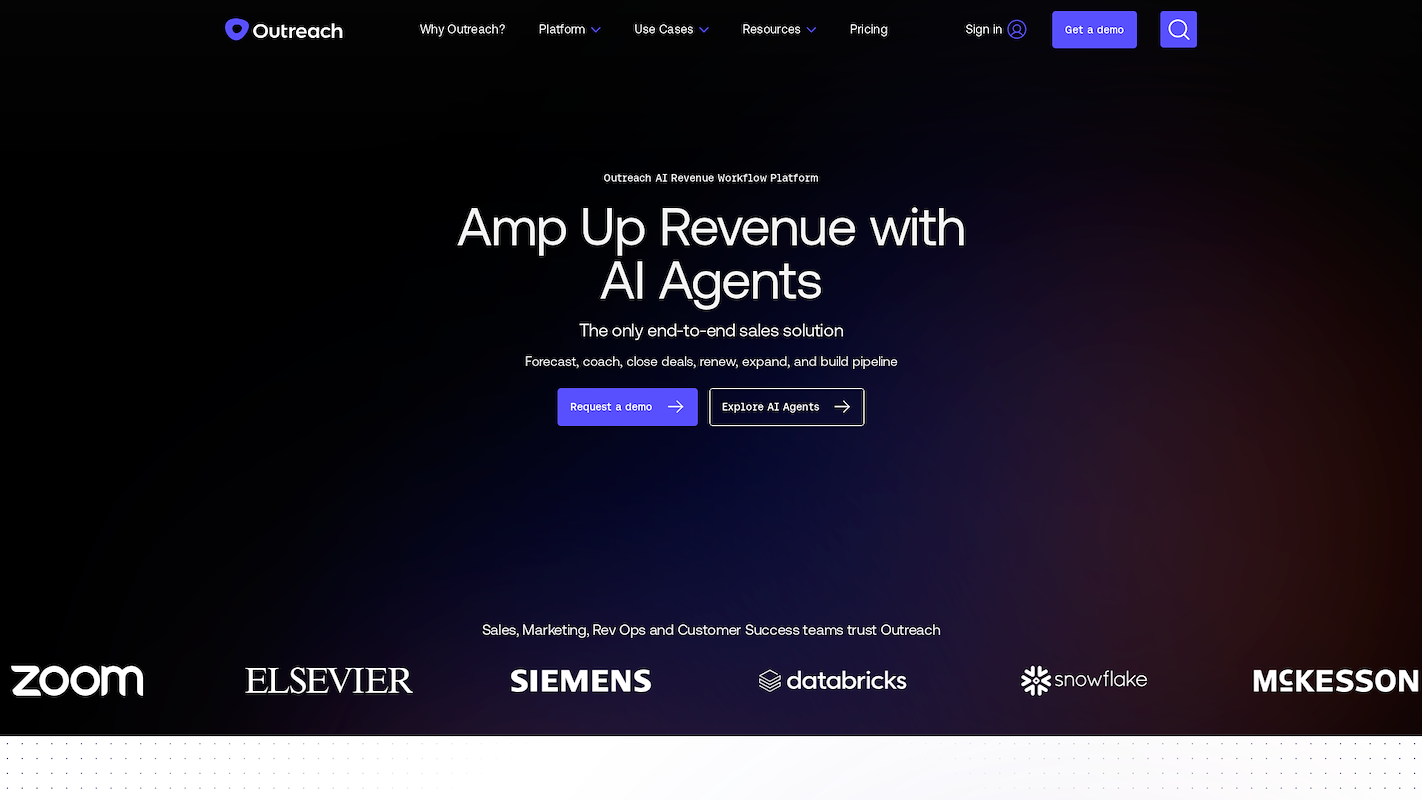
Outreach is an AI-powered platform that offers an end-to-end sales execution solution for revenue teams. It combines AI agents, data-driven workflows, and forecast models to help organizations build pipeline, manage deals, and coach representatives. The platform is designed to support the full revenue cycle, from initial outreach to account expansion, with a focus on security and governance for customer data.
Outreach's Main Features
- Predicts revenue outcomes, identifies pipeline gaps, and runs scenario forecasts using pipeline and forecast analytics.
- Provides AI-driven representative coaching through Kaia, which offers meeting summaries, Q&A, and analytics.
- Surfaces risks, next steps, and recent activity on any account or deal with Smart Account Assist and Smart Deal Assist.
- Detects topics and buyer sentiment across meetings, calls, and emails to analyze interactions.
How Outreach Compares to lemlist
Average Review Score: 4.3/5 stars based on 3,479 G2 reviews.
- Outreach provides revenue prediction tools that forecast outcomes and identify pipeline gaps. This offers a broader view of the sales cycle compared to lemlist's focus on outreach metrics.
- The platform includes an AI coaching tool, Kaia, that analyzes sales calls and provides representative feedback. This is different from lemlist's AI, which personalizes outreach messages.
- Its Smart Deal Assist feature helps manage deals through risk identification and suggested next steps. This supports the full sales cycle, while lemlist concentrates on initial outreach.
- The tool analyzes buyer sentiment from calls and emails for deeper interaction insights. This level of analysis is more advanced than lemlist's focus on open and click rate metrics.
Outreach's Limitations Compared to lemlist
- Outreach does not have the advanced image and video personalization tools found in lemlist. This may be a consideration for teams whose campaigns depend on unique visuals to engage prospects.
- It lacks a large, active user community for peer support, which is a notable feature of lemlist. Users might find fewer opportunities to exchange successful tactics compared to the lemlist community.
- Some users find the platform can be complex and costly for smaller teams. In contrast, lemlist provides a more accessible entry point with its free and lower-priced plans.
Cost and Value Comparison
Outreach requires a custom quote, while lemlist offers transparent pricing starting at $55 per year. Since pricing models can vary, for the most accurate information, we recommend visiting Outreach's official website.
4) Salesloft
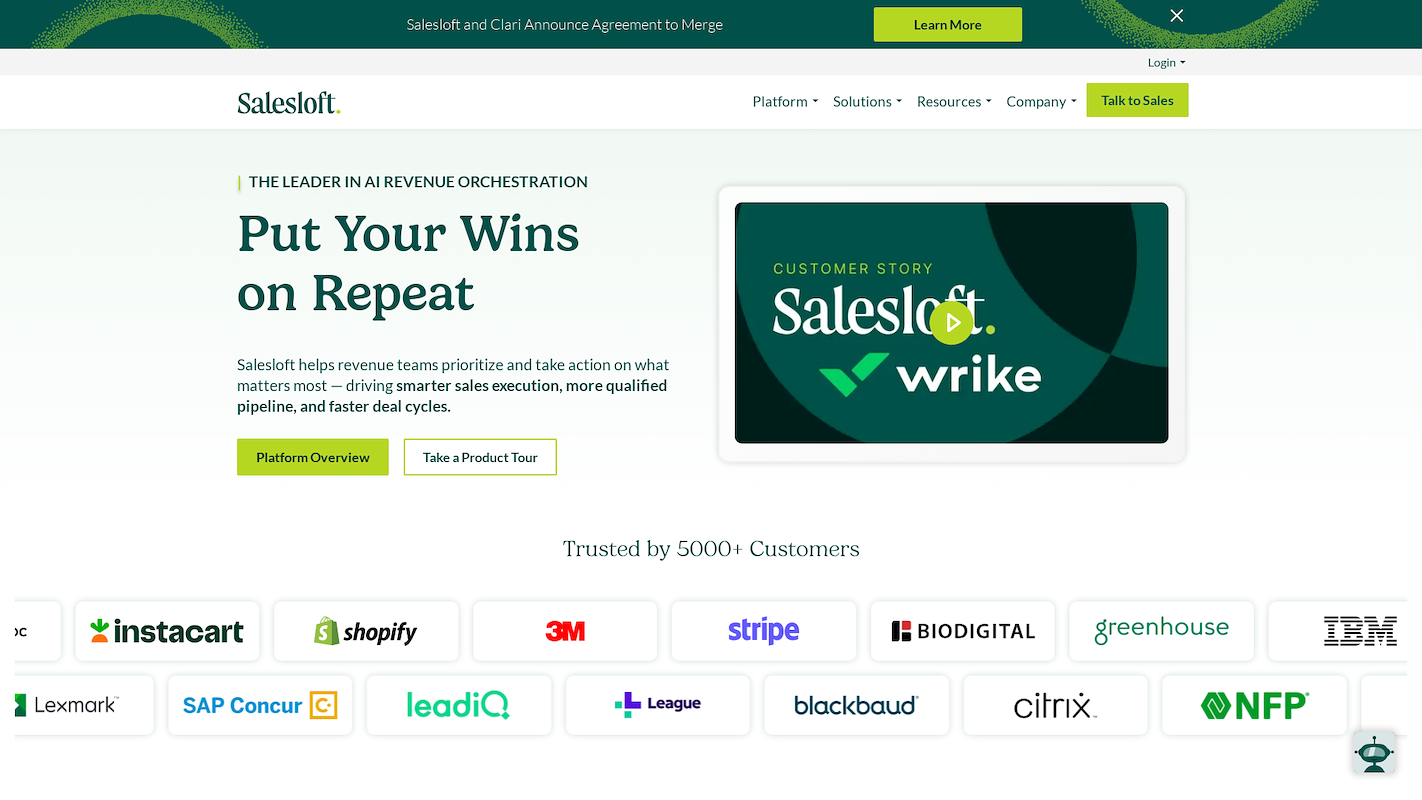
Salesloft is a sales engagement platform that helps revenue teams generate pipeline and manage deals. It provides a system for sellers to execute multi-channel outreach, from emails and calls to social touches. The platform structures the entire sales workflow to guide sellers on their next steps.
Salesloft's Main Features
- Uses an AI engine, Rhythm, to prioritize and recommend the right actions for sellers at the right moments.
- Manages deals and pipelines with AI insights that identify risk, suggest next steps, and track velocity.
- Combines real-time deal data, AI, and seller input to create more accurate sales forecasts.
- Identifies coaching opportunities for sales representatives through data-driven analysis to scale best practices.
How Salesloft Compares to lemlist
Average Review Score: 4.5/5 stars based on 4,145 G2 reviews.
- Salesloft provides deal management and forecast tools for the full revenue cycle. This offers a broader scope than lemlist, which concentrates on top-of-funnel outreach.
- Its AI engine, Rhythm, prioritizes a seller's daily tasks to guide their workflow. This is a different use of AI compared to lemlist, which applies it for message personalization.
- The platform includes sales coaching features that analyze call data for representative improvement. lemlist's analytics focus on outreach engagement metrics.
- The tool integrates calling functions, such as call recording and click-to-call, into outreach sequences. lemlist's main communication channels are email and LinkedIn.
Salesloft's Limitations Compared to lemlist
- Salesloft lacks the advanced image and video personalization tools found in lemlist. This may be a factor for teams whose outreach strategies depend on highly customized visuals to engage prospects.
- The tool does not foster a large user community for peer support, which is a notable feature of lemlist. Users might find fewer public forums to exchange successful tactics compared to the lemlist community.
- Some users report that the platform can be complex for smaller teams. In comparison, lemlist offers a simpler entry point with its free plan and lower-priced tiers, which may be more suitable for businesses with limited budgets.
Cost and Value Comparison
Salesloft requires a custom quote, while lemlist offers transparent pricing with a free plan and paid options starting at $55 per year. For the most accurate pricing information, we recommend visiting Salesloft's official website.
5) Woodpecker
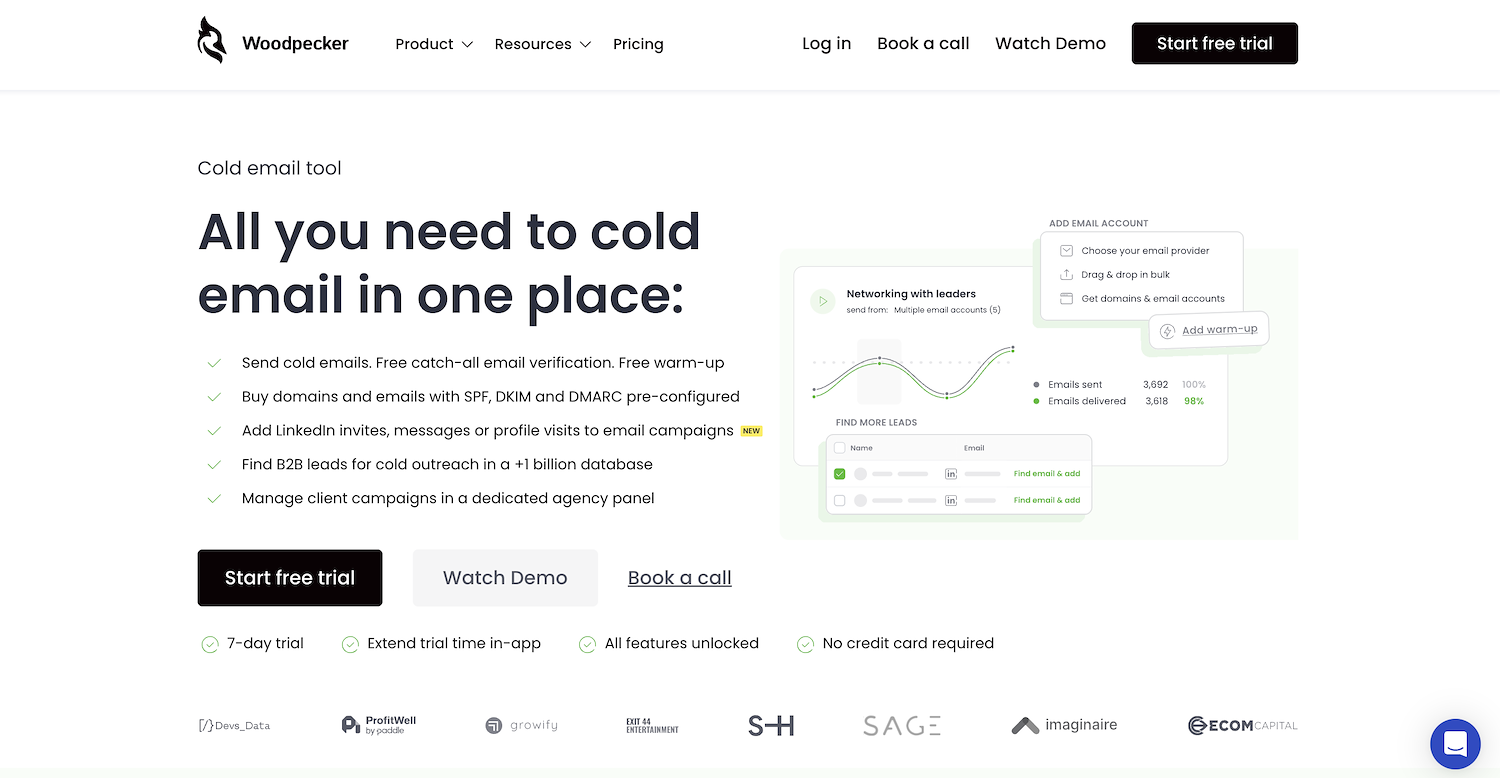
Woodpecker is a sales automation tool that helps B2B companies with their outreach. Teams can use it to contact prospects across different channels and schedule automatic follow-ups. Its use cases are lead generation and sales engagement, so it provides features to manage the communication flow with potential customers.
Woodpecker's Main Features
- Combines email and LinkedIn automation into a single interface with a centralized inbox for all outreach replies.
- Offers the option to purchase fully configured domains and inboxes with SPF, DKIM, and DMARC settings.
- Provides an agency panel for managing multiple client campaigns from a single dashboard.
- Applies condition-based logic to campaigns and uses adaptive sending to automatically throttle volume within provider limits.
How Woodpecker Compares to lemlist
Average Review Score: 4.5/5 stars based on 93 G2 reviews.
- Woodpecker provides a dedicated panel for agencies to manage multiple client accounts from one dashboard, which is different from lemlist's focus on individual team workflows.
- The tool offers an option to buy fully configured domains and inboxes, which simplifies the technical setup compared to lemlist, where users must configure their own domains.
- It uses condition-based logic for campaigns and includes adaptive sending to manage volume automatically, a different approach to deliverability than lemlist's standard schedules.
- The platform includes a white-label reporting app for clients to view campaign results, a feature not available in lemlist and designed specifically for agency use.
- It allows A/B tests with up to five different email versions in a single campaign, offering more variants for testing than lemlist's A/B test capabilities.
Woodpecker's Limitations Compared to lemlist
- Woodpecker does not have the advanced image and video personalization features that lemlist offers. This can be a drawback for campaigns that depend on unique visuals to capture a prospect's attention.
- The tool lacks a large, active user community like the one lemlist fosters. This means users might find fewer opportunities to exchange successful strategies or receive peer support.
- Some users report that its customization options are limited. Compared to lemlist's more flexible API, this might offer less room to create highly specific sales workflows.
Cost and Value Comparison
Woodpecker's pricing starts at $29 per month for its cold email plan. In contrast, lemlist offers a free plan and an Email Pro option at $55 per year, making its entry point more affordable for basic email outreach.
Try 11x Digital Workers for Sales
For teams interested in adding digital workers to their sales process, 11x provides this option. They can take on tasks like lead research and initial outreach, letting your sales team concentrate on qualified leads.
You can explore how these digital workers operate and determine if they align with your company's sales objectives.
At 11x, we use AI to run your sales playbook. Our agent, Alice, finds accounts, enriches their data, and manages outreach. Julian qualifies prospects and schedules meetings. We consolidate tools for intent signals and email warmup into one platform, so you don't need separate software.
Book a demo to see 11x in action.
6) Snov.io

Snov.io is a sales automation platform with tools for lead generation and outreach. It offers a B2B database to find contacts, an email verifier to check address validity, and a campaign builder for automated sequences. The platform supports sales engagement through multichannel communication.
It is a solution for teams that need to manage the top-of-funnel process, from prospect discovery to initial contact, within one system.
Snov.io's Main Features
- Includes a built-in sales CRM with Google Calendar sync, automated deal stages, and deal-loss analytics.
- Verifies email addresses with a 7-tier process that has 98% accuracy and bypasses gray-listing.
- Connects to other tools through more than 5,000 native integrations and a REST API.
- Provides a multilingual interface that supports English, Portuguese, Spanish, Ukrainian, and Chinese.
How Snov.io Compares to lemlist
Average Review Score: 4.6/5 stars based on 450 G2 reviews.
- Snov.io includes a built-in sales CRM to manage deals and pipelines, which is different from lemlist's focus on the outreach stage of the sales process.
- The platform provides a 7-tier email verification process with 98% accuracy, offering a more detailed system than lemlist's standard email checking.
- It connects with other tools through more than 5,000 native integrations, providing a wider range of connectivity options compared to lemlist.
- The tool's interface supports multiple languages, including Spanish and Chinese, making it accessible for international teams, unlike lemlist's platform.
Snov.io's Limitations Compared to lemlist
- Snov.io does not have the advanced image and video personalization features found in lemlist. This can be a drawback for campaigns that depend on unique visuals to get a prospect's attention.
- It lacks a large, active user community like the one lemlist provides. This means users might find fewer opportunities to exchange successful strategies or get peer support for their campaigns.
- Some users find its AI capabilities are more focused on data and verification. This is different from lemlist's AI, which is built to create highly personalized message content at scale.
Cost and Value Comparison
Both platforms provide a free option. lemlist's paid Email Pro plan is $55 per year, offering a lower entry cost than Snov.io's Starter plan at $39 per month. For more features, lemlist's multichannel plan is $79 per month, while Snov.io's Pro plan is $99 per month.
7) Apollo.io
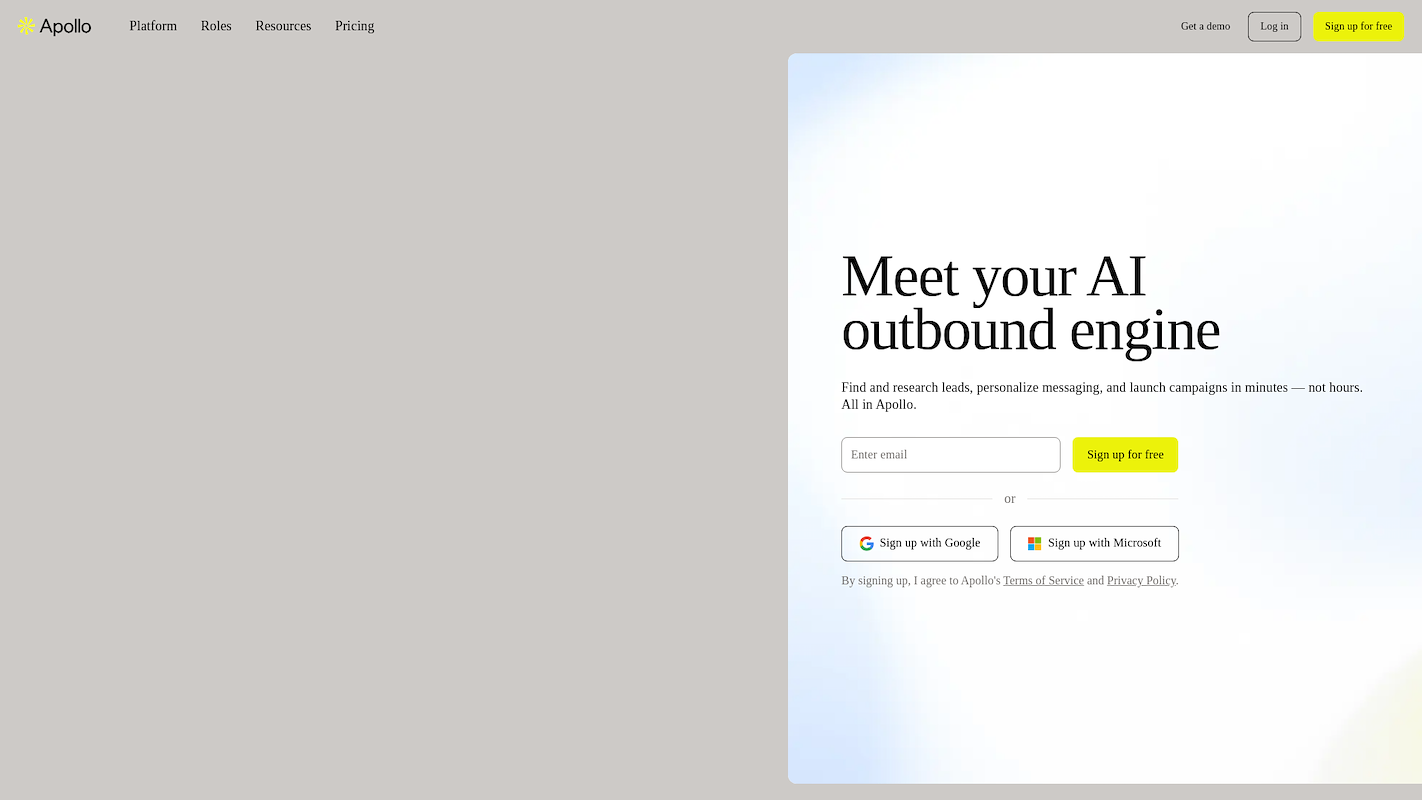
Apollo.io is a sales intelligence and engagement platform. It provides a B2B database with contact and company data that sales teams use for prospect discovery. The platform also includes tools to create outreach sequences across email and other channels.
Teams can find customers, engage them through automated messages, and manage their sales pipeline within a single system.
Apollo.io's Main Features
- Provides a B2B database with contact and company data for prospect discovery.
- Creates outreach sequences for engagement across email and other channels.
- Manages the sales process from customer discovery to pipeline management in a single system.
How Apollo.io Compares to lemlist
Average Review Score: 4.7/5 stars based on 8,904 G2 reviews.
- Apollo.io provides a B2B database with over 210 million contacts, offering a more extensive source for prospecting compared to lemlist's contact database.
- It functions as an end-to-end platform that includes deal management and analytics, while lemlist concentrates on the top-of-funnel outreach stages.
- The tool includes buyer intent data to help identify active prospects, providing a different layer of lead qualification than lemlist's standard database.
- Its intelligence engine offers recommendations and analytics to guide the sales process, which is different from lemlist's AI that focuses on personalizing outreach messages.
Apollo.io's Limitations Compared to lemlist
- Apollo.io does not offer dynamic image and video personalization within emails. In contrast, lemlist allows users to embed custom visuals with prospect data, which can increase engagement for certain outreach strategies.
- It does not foster a large user community for strategy exchange, unlike lemlist's active peer support network. Users might find fewer public channels to get campaign advice from peers.
- The platform's AI focuses on intelligence and analytics rather than creative message personalization. Lemlist's AI, in comparison, helps write and customize outreach copy, which may be more useful for teams focused on content quality.
Cost and Value Comparison
Both platforms offer a free plan. lemlist's Email Pro plan at $55 per year is a more affordable entry point for basic outreach compared to Apollo.io's Basic plan at $49 per month. For multichannel capabilities, both tools offer a plan at $79 per month, making them directly competitive.
8) Yesware

Yesware is a sales toolkit that works from a user's inbox. It gives sales professionals tools to prospect, schedule meetings, and follow up. The platform integrates with Gmail and Outlook and supports multi-channel campaigns, so teams can manage sales work without a separate application.
Yesware's Main Features
- Works from within a user's Gmail or Outlook inbox as an add-on.
- Tracks email opens, link clicks, and attachment activity to monitor prospect engagement.
- Schedules emails and manages sales tasks through integrated workflows inside the email platform.
- Creates and manages email templates for repeatable outreach campaigns.
How Yesware Compares to lemlist
Average Review Score: 4.4/5 stars based on 819 G2 reviews.
- Yesware integrates directly into a user's Gmail or Outlook inbox, allowing outreach to be managed from a familiar interface. This is different from lemlist, which operates as a separate platform.
- The tool tracks when prospects view email attachments, providing a specific engagement signal. This offers more detail than lemlist's standard open and click tracking.
- It adds sales features to an existing email client, which can offer a simpler user experience. This contrasts with lemlist's platform, which some users report has a learning curve.
- Its meeting scheduler works from within the inbox, providing an integrated way to book appointments. This differs from lemlist, where scheduling is managed as part of a separate campaign workflow.
Yesware's Limitations Compared to lemlist
- Yesware does not offer advanced image and video personalization. This is different from lemlist, which allows users to embed custom visuals with prospect data for more engaging outreach.
- The tool operates as an inbox add-on, which may not be ideal for teams that want a separate platform. Lemlist, in contrast, is a standalone application that centralizes all outreach activities.
- It lacks a large user community for peer support. This means users have fewer opportunities to exchange successful tactics compared to the active network lemlist provides.
- The platform's features do not include AI for content creation. This is different from lemlist's AI, which helps write and personalize outreach messages at scale.
Cost and Value Comparison
Yesware's Pro plan starts at $15 per month, while lemlist provides a free plan and an Email Pro option at $55 per year, offering a lower entry cost. For more features, Yesware's Premium ($35/month) and Enterprise ($65/month) plans are more affordable than lemlist's Multichannel Expert plan ($79/month).
9) Klenty

Klenty is a sales engagement platform that helps sales teams automate outreach across email, calls, and LinkedIn. The system allows users to execute multi-channel cadences, manage prospect communication, and book meetings. It is designed for sales development representatives to handle their outbound sales process from one place.
Klenty's Main Features
- Integrates with CRMs like Salesforce, Pipedrive, and Hubspot to help execute custom workflows.
- Tracks email attachment activity to monitor prospect engagement beyond standard open and click rates.
- Includes task and workflow management to structure sales processes and guide representative actions.
- Provides analytics on workflow performance, including open rates and link activity, for reporting purposes.
How Klenty Compares to lemlist
Average Review Score: 4.6/5 stars based on 387 G2 reviews.
- Klenty offers deeper CRM integrations with platforms like Salesforce and Pipedrive. This allows for custom workflows directly tied to your CRM, which is a more integrated approach than lemlist's standard connections.
- The tool tracks when a prospect opens an email attachment. This provides a more specific engagement signal compared to lemlist, which focuses on email opens and link clicks.
- It includes specific solutions for dialing challenges in India. This offers a specialized calling feature for teams targeting that region, which is not a focus for lemlist.
- Its workflow management guides sales representatives on their next steps. This provides a more structured process for daily tasks than lemlist's campaign-based system.
Klenty's Limitations Compared to lemlist
- Klenty does not have the advanced image and video personalization features found in lemlist. This can be a drawback for campaigns that depend on unique visuals to capture a prospect's attention.
- The platform lacks a large, active user community like the one lemlist provides. This means users might find fewer opportunities to exchange successful strategies or get peer support.
- Its AI capabilities focus on workflow automation. This is different from lemlist's AI, which is built to help users write and personalize outreach copy at scale.
Cost and Value Comparison
lemlist offers a more accessible entry point with a free plan and an Email Pro option at $55 per year, while Klenty's starter plan is $50 per month. For multichannel features, Klenty's Growth plan at $70 per month is slightly less expensive than lemlist's Multichannel Expert plan at $79 per month.
10) Mixmax
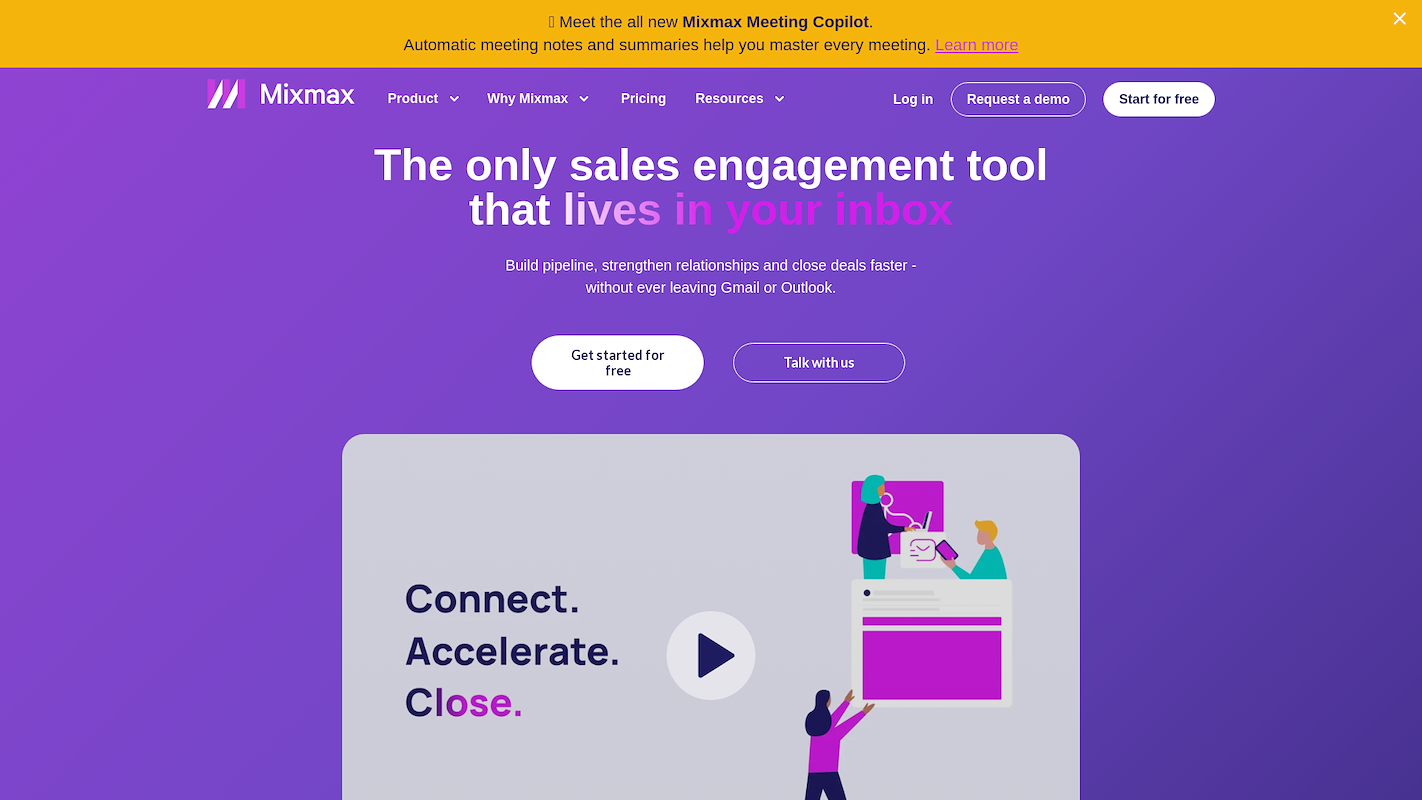
Mixmax is a sales engagement platform that operates within a user's Gmail account. It provides tools for sales representatives and leaders to connect with prospects and customers. The system supports pipeline creation and deal management through automated sequences and integrated calendar functions, all from the inbox.
Mixmax's Main Features
- Operates from within a user's inbox, integrating with their existing email platform.
- Adds interactive polls and surveys directly into emails to engage recipients.
- Tracks email opens, link clicks, and attachment activity for engagement monitoring.
- Automates CRM updates and manages tasks through integrated workflows.
How Mixmax Compares to lemlist
Average Review Score: 4.6/5 stars based on 1,433 G2 reviews.
- Mixmax operates directly inside a user's Gmail inbox. This is different from lemlist, which is a separate application and requires users to switch between their email and the platform.
- It allows users to add interactive polls and surveys into emails. This provides a different way to engage prospects compared to lemlist's focus on image and video personalization.
- The tool tracks when a prospect opens an email attachment. This gives a more specific engagement signal than lemlist's standard open and click tracking.
- Its AI provides insights on who to contact and when. This is a different approach from lemlist's AI, which centers on personalizing the content of the message.
Mixmax's Limitations Compared to lemlist
- Mixmax does not have advanced image and video personalization features. This is different from lemlist, which allows users to embed custom visuals with prospect data for more engaging outreach campaigns.
- The tool operates as an inbox add-on, which might not suit teams that prefer a separate platform. In contrast, lemlist is a standalone application that centralizes all outreach activities.
- It lacks a large user community for peer support. Users may find fewer opportunities to exchange successful tactics compared to the active network that lemlist provides.
Cost and Value Comparison
lemlist offers a more affordable entry point with a free plan and an Email Pro option at $55 per year, while Mixmax's Growth plan starts at $49 per month. For multichannel features with CRM integration, Mixmax's Growth + Salesforce plan at $69 per month is less expensive than lemlist's Multichannel Expert plan at $79 per month.
Which One Should You Go With?
The right lemlist alternative depends on your team's specific needs, budget, and sales process. This guide reviewed several options and their trade-offs to help you make an informed decision.
If you want to replace multiple sales tools and use AI agents for your GTM motion, 11x offers a unified platform. Our digital workers can manage prospecting, outreach, and lead qualification, which lets your sales team focus on closing deals.




